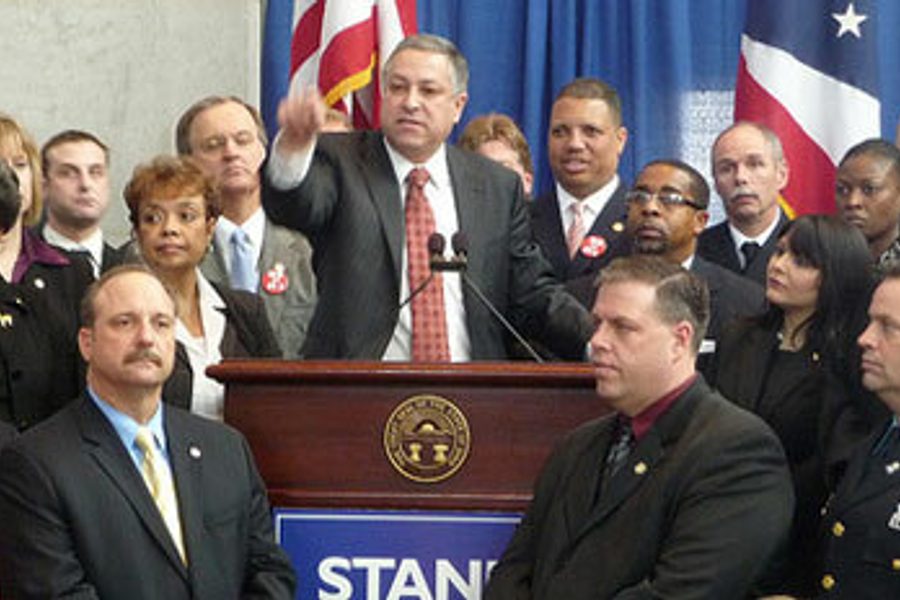
The movement has been set back for now, but the standoff in Madison captured labor’s political imagination. Although the Republicans have cynically used the “nuclear option” to ram through the anti-union bill, the battleground will now just shift to other states.
Ohio lawmakers are mulling a bill similar to Wisconsin’s, which would restrain the collective bargaining rights of some 360,000 state and local employees.
Ohio does not need as many votes for a quorum. This means Democrats cannot hold up the voting process by going AWOL, as they did in Wisconsin and are still doing in Indiana (where unions are fighting proposals to further erode union rights and public education). But in Ohio’s case, Madison-style people power could be deployed in a more concrete way, according to some lawmakers. House minority leader Armond Budish told Bloomberg News that even if the bill initially passes, he and other Democrats will mobilize citizens to thwart the legislation through other channels, through public pressure and perhaps ultimately, the ballot box:
Too few to block Republicans from having a quorum, Ohio Democrats are asking for more public involvement and hearings on the bill in an effort to sway opinion and will seek a ballot issue to repeal it if necessary, Budish said.
“If I have to take the lead on a statewide referendum, we will fight until we win,” Budish, the House minority leader, said in a telephone interview from Columbus….
With Republicans holding a 59-to-40 seat advantage in the House, Democrats should focus on a repeal referendum, said Representative Robert Hagan, a Democrat from Youngstown.
“What we’re doing now is performing a charade,” Hagan said in an interview. “They should get it over with, and we should put this on the ballot as soon as possible.”
With passage in the House all but certain, Ohio could now overtake Wisconsin as a bellwether for the struggle. After the fireworks in Madison, labor activists recognize that the partisan gridlock over collective bargaining rights is merely a proxy battle for a new kind of class antagonism that has emerged from the Great Recession.
Ohio’s referendum process offers a form of direct democracy that Wisconsin Republicans stridently denied to protesters by ignoring, vilifying and shutting out demonstrators at the capitol.
Bloomberg reports that voters can launch a ballot initiative
if petition forms with more than 231,000 voters’ signatures are filed within 90 days of the law’s approval, according to the secretary of state’s office. The number of signatures is 6 percent of the total vote cast for governor last year.
Gathering that many petitions in three months is no small feat, though the required number of signatures equals just under two-thirds of the number of workers potentially impacted by the bill. More importantly, the spirit of protest across the Midwest has truly gone viral, inspiring parallel demonstrations in Indiana, Ohio and other states, and cheers across the Twitterverse, pizza from Haiti, and picketing from Cairo. And on top of potential court challenges, there are rising calls for a general strike to paralyze Gov. Walker’s administration. In the wake of that outpouring of solidarity, a conventional referendum seems almost too easy.
In many ways, it is. Which is why the temporary defeat in Wisconsin should have a more enduring influence on the campaign to protect union rights than any other tactic. The battle for labor’s integrity won’t be won or lost on the political chessboard of a state legislature.
As activists regroup and take stock of what they’ve gained these past few weeks, they can still claim one victory: they never gave an inch. And by standing their ground, they gave workers across the country the momentum to push ahead to November and beyond.

I hope you found this article important. Before you leave, I want to ask you to consider supporting our work with a donation. In These Times needs readers like you to help sustain our mission. We don’t depend on—or want—corporate advertising or deep-pocketed billionaires to fund our journalism. We’re supported by you, the reader, so we can focus on covering the issues that matter most to the progressive movement without fear or compromise.
Our work isn’t hidden behind a paywall because of people like you who support our journalism. We want to keep it that way. If you value the work we do and the movements we cover, please consider donating to In These Times.
Michelle Chen is a contributing writer at In These Times and The Nation, a contributing editor at Dissent and a co-producer of the “Belabored” podcast. She studies history at the CUNY Graduate Center. She tweets at @meeshellchen.







